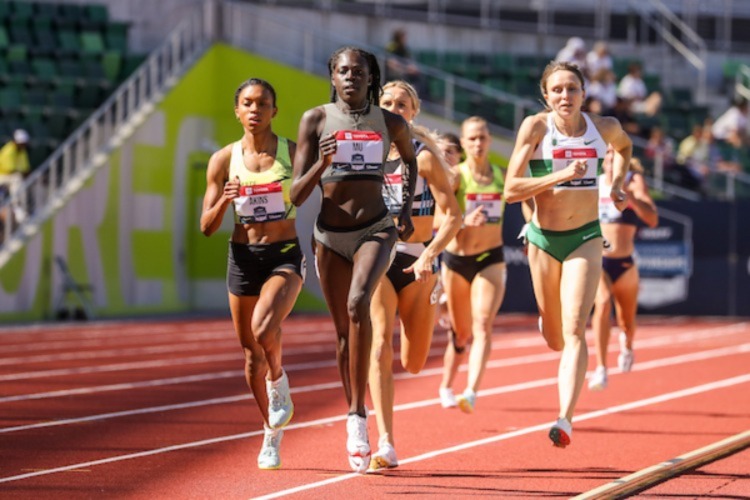USATF / Day Two: Focus On Speed
Eugene, Oregon
University of Oregon
Hayward Field
June 24th, 2022
Frank Shorter, gold and silver Olympic medalist in the marathon, has long been attributed to the saying, “You can’t run away from speed.” It was the Yalie’s way of saying that on the track or in the field or even on the roads you cannot escape the need for speed, the need to be able to accelerate your pace, to step on the gas, to meet the challenge of your competitors. Here in Eugene, those in Hayward Field had the opportunity in Day Two of the USATF Outdoor Track & Field Championships to witness in action four tremendous athletes who clearly live by that credo and can really dish out the speed.
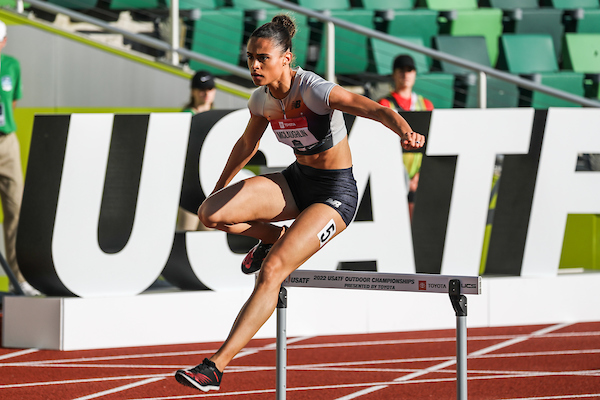
Sydney McLaughlin competes in the Day Two semi-final round of the 400-meter hurdles. Still, only in her early 20’s, McLaughlin is already one of the most decorated and respected athletes in track & field. As the reigning Olympic gold medalist and world record holder in the 400-meter hurdles (51.46), she is coached by Bobby Kersee who has helped many athletes to enhance their performances under his savvy tutelage.
It is evident that the former University of Kentucky star knows the importance of speed. She periodically competes in the open 400 meters – one lap, but without the hurdles. That under-distance speed work at tempos meaningfully higher than the world-class 400 hurdle pace helps Sydney hone her speed, keep her sharp, and allows her to handle more comfortably the stresses of the world-class 400-meter hurdle pace which, while still fast, is slightly less than the even faster pace of a world-class open 400 meters. McLaughlin’s 400-meter PR is 50.07 which she set as a teenager. As a high schooler, she ran a relay leg in 49.85 As presently a more mature, stronger athlete, McLaughlin could likely could likely run even faster now. Remember: McLaughlin has Olympic and World Championship gold medals for her participation in the USA’s recent 4x400m relay victories. McLaughlin isn’t running away from speed. She is running to it!
In McLaughlin’s Day Two semi-final race, the world record holder offered a glimpse as to how ready she is for Saturday’s final. At the crack of the starter’s pistol, McLaughlin went to work, bursting out of the blocks and quickly making up the stagger on the athletes in the lanes ahead of her. Hurdling with either leg, the New Balance athlete looked invincible as she easily quickened her pace over the final 200 meters for an easy victory in 52.90. None of her competitors in either heat were within 2 seconds of her. Sydney McLaughlin is ready to do something special in Saturday’s final.
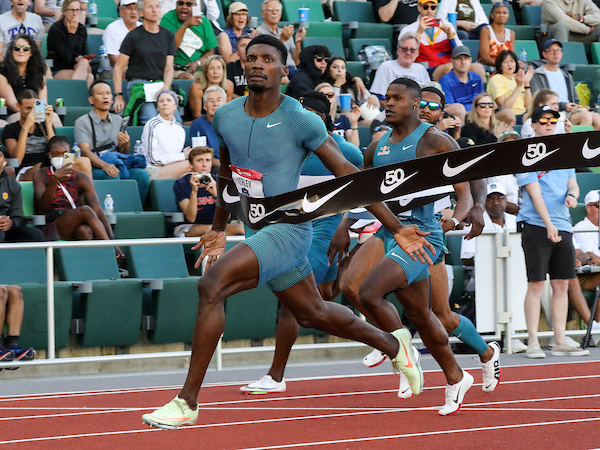
Fred Kerley, who competed on Day Two in the semi-final round and the final round of the men’s 100m, is another exceptional athlete who has made a greater commitment to speed. And it has paid off. Many scoffed at the idea that a quarter-miler like Kerley could successfully transition down in distance and compete effectively with world-class 100-meter specialists. But they were wrong.
Kerley, with the body of an Adonis, is a muscular man. He has the strength. But he needed the speed. Kerley’s personal-best 400-meter time of 43.64 seconds makes him the eighth-fastest man in history over 400 meters. After the pandemic, Kerley chose to focus on the 100 meters during the Olympic cycle to improve his basic speed for future attempts at a sub-43 400 meters. The decision to move down paid off as he won the silver medal in the 100 m at the 2020 Olympic Games with a 9.84 performance. That personal best time makes Kerley the fifteenth fastest man in history over the straightaway sprint.
How is he faring now? Kerley is one of only 3 men, along with Michael Norman and Wayde Van Niekerk, to go sub 10 seconds in 100m, sub 20 seconds in 200m, and sub 44 seconds in 400m. Again, he is not running away from speed, he is embracing it!
And the versatile sprinter was ready to display his range and speed on Day Two. As is customary in the sprints, the 100-meter competitors were poised for the usual sprint doubleheader – a semi-final round followed by the final about two hours later. Kerley used the first race to send an unmistakable message. The Nike athlete who clocked a leading 9.83 in the opening round blasted a 9.76 time in his semi-heat. Kerley’s world-leading performance is a personal best for Kerley, set a new Hayward Field and meet record, and is the 5th fastest 100-meter clocking ever by an American.
The men’s 100m final proved to be special. Christian Coleman – who ran 9.87 in his semi – elected to skip the final. His DNS will do no harm as the Doha 100m champion has an automatic entry for next month’s world championships. But the remaining 7 finalists put on quite a show. Another powerful start by Kerley quickly left no doubt on who would be the victor. But the other finalists provided their own electricity with sterling dashes of their own. Following Kerley’s winning time of 9.77, the remaining 6 athletes all posted sub-10 second clockings as well – a sprint feat that had never before been accomplished. His speed in check, Kerley is ready to tackle his next challenge in this national championship gathering: the preliminary round, the semi-final, and the final of the 200-meter dash. Those who witnessed Kerley’s dominance in the 100 meters already know he has the speed and will be a force to be reckoned with.
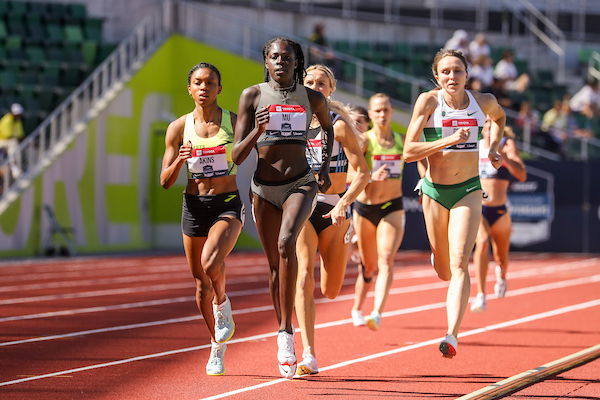
Athing Mu still radiates a certain mystery on the track. She has been a highly-visible track performer for about the last three years. But during that time period, we have yet to see this phenomenal athlete grit her teeth to fend off a serious challenge. She makes it all look so easy. While her natural skills are undeniable, there is more to her amazing and wide-ranging talent than meets the eye. There is an old shop-worn expression: “Hard work beats talent when talent doesn’t work hard.” But when talent does work hard, you have something quite special. You have Athing Mu.
Mu’s work ethic combined with thoughtful direction provided by those around her has molded her into a long-sprinter / middle-distance talent that is rare. Her performances in both the 400m and the 800m are beautiful – conjuring up images of Alberto Juantorena.
One of the essential keys to her currently-limitless success has been her commitment to speed and her embrace of different distances. Whether it is running a leg on USA’s gold medal Olympic 4x400m relays, racing and winning a 600-meter race before 40,000+ at the Penn Relays, or gliding away from talented competitors in the 800 meters, she has shown she can handle it well.
Her open-mindedness on racing varied distances has added spice to her performances and, perhaps more importantly, has honed her already-impressive speed and taken it to a new level. She sports a 400m PR of 49.57. When she races the 800 meters, how many of her competitors can run a lap in under 50 seconds? It is this wide-ranging ability – a product of natural talent and training commitment – that makes a great athlete even better.
Mu’s talent was put on display again on Day Two. In her 800m semi-final, the Nike athlete effortless took the lead, splitting 200 meters in 27.0 and taking the bell at 57.0. While an opening 400 in 57 might be taxing for some semi-finalists, it is a pace that is not likely to faze an athlete who can run a sub-50 lap. Unchallenged, Mu glided on to victory crossing the line in 1:57.55. Racing in her wake, 5 other athletes in Mu’s heat broke 2:00, including hard-luck Sabrina Sutherland whose 1:59.70 proved insufficient to advance to Sunday’s final. In her post-race interview, the relaxed winner casually noted, “I ran 1:57 today…”. Everyone is eager to see what Athing Mu will do on Sunday’s final
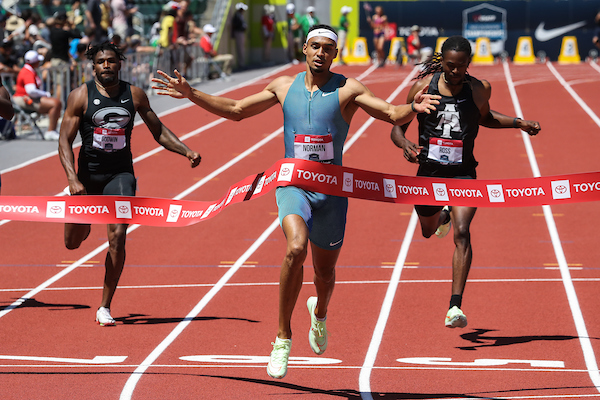
Michael Norman is yet another gifted athlete who also prepares for a wide range of events and in doing so strengthens his speed. The former USC athlete holds the world record in the indoor 4oo meters at 44.52. His outdoor 400-meter PR is 43.45 and currently ranks #4 on the all-time world list. Yet he also has world-class skills in the 200 meters, having posted sub-20 second clockings to prove it. And like Fred Kerley, Michael Norman is one of only 3 men, along with Kerley and Wayde Van Niekerk to go sub 10 seconds in 100m, sub 20 seconds in 200m, and sub 44 seconds in 400m.
Norman’s versatility and his accompanying speed improved by the breadth of his skills have been apparent in this championship. Entering the championship with a world-leading mark of 43.60 which he rang up at the Pre meet, Norman has been a picture of quiet preparation and confidence. In the opening round, the former Bowerman Award winner posted a mark of 44.72, the fastest of the day by a meaningful margin. His performance in Friday’s semi was textbook round behavior as Norman chipped away a little more time with a clocking of 44.28, again leading all other competitors. It is clear that his 200-meter work has polished his speed for the 400. And his 400-meter racing has built his strength for the furlong. All of this suggests that we could be treated to a terrific performance by Norman in Saturday’s 400-meter final. / Dave Hunter /
Author

Dave Hunter is an award-winning journalist who is a U.S. Correspondent for Track & Field News. He also writes a weekly column and serves as Senior Writer for www.RunBlogRun.com, and covers championship track & field competition domestically and in such global capitals as Moscow, Birmingham, Zurich, Brussels, Beijing, Rio de Janeiro, Zagreb, Ostrava, and Doha. Hunter frequently serves as the arena or stadium announcer for championship track & field gatherings, including the Ivy League, the Big East, the Mid-American Conference, the NAIA, the Big Ten, and the Millrose Games. Hunter has undertaken foreign and domestic broadcast assignments. He ran his marathon P.R. 2:31:40 on the Boston Marathon course back in the Paleozoic Era. To find out more about Dave, visit his website: www.trackandfieldhunter.com He can be reached at: dave@trackandfieldhunter.com
View all posts

